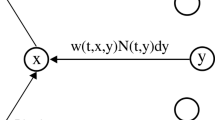Abstract
The problem of developing a neural network with a given pattern of the state sequence is considered. A neural network structure and an algorithm of forming its bond matrix which lead to an approximate but robust solution of the problem are proposed and discussed. Limiting characteristics of the serviceability of the proposed structure are studied. Various methods of visualizing dynamic processes in a neural network are compared. Possible applications of the results obtained for interpretation of neurophysiological data and in neuroinformatics systems are discussed.
Similar content being viewed by others
References
J. J. Hopfield, “Neural networks and physical systems with emergent collective computational abilities,”Proc. Natl. Acad. Sci. USA,79, 2554 (1982).
J. J. Hopfield, “Neurons with graded response have collective computational properties like those of two-state neurons,”Proc. Nat. Acad. Sci. USA,81, 3088 (1984).
W. R. Foster, J. J. Hopfield, L. H. Ungar, and J. A. Schwaber, “Nonlinear neural membrane properties can provide highly robust dynamic neural behaviors,” in:Neural Network for Computing Conference, Snowbird, Utah, April 13–16, 1993, p. 25.
V. L. Dunin-Barkovskii, “Configurational generators of neural rhythm,”Biofizika,29, No. 5, 899 (1984).
E. V. Dunina-Barkovskaya, “Imitational model of learning,”Graduate's Thesis [in Russian], Faculty of Psychology, Moscow State University, Moscow (1985).
E. V. Dunina-Barkovskaya and V. L. Dunin-Barkovsky, “Analog/digital controversies in neural computations,”Neural Network World,3, No. 4, 361 (1993).
D. J. Amit, H. Gutfreund, and H. Sampolinsky, “Spin glass model of neural network,”Phys. Rev. A,B2, 1007 (1985).
D. Hebb,The Organization of Behavior, Wiley, New York (1949).
I. P. Pavlov, “Two-decade experience of objective study of the higher nervous activity of animals,” in:Complete Collected Works [in Russian], Izd. Akad. Nauk, Moscow, SSSR (1961)
A. B. Kornhber, “Die Learnmatrix,”Kybernetik,1, 101 (1959).
L. I. Gutenmakher,Electronic Informational and Logical Machines [in Russian], Izd. Akad. Nauk, Moscow (1962).
D. Marr, “Simple memory: A theory for archicortex,”Philos. Trans. Roy. Soc.,B-262, 23 (1971).
H. Sompolinski, “Kantor,”Phys. Rev. Lett.,57, 2861 (1986).
D. Kleinfield,Proc. Natl. Acad. Sci. USA,83, 9469 (1986).
T. Aoyagi, “Temporal association realized by a network of bursting neurons,” in:Proceedings of IJCNN'93, Nagoya (1993), p. 2359.
M. Reiss and J. G. Taylor, “Storing temporal sequences,”Neural Network,4, 773 (1991).
C. M. Privitera and P. Morasso, “A new approach to storing temporal sequences,” in:Proceedings of IJCNN'93, Nagoya (1993), p. 2745.
B. Gas and R. Natowicz, “Extending discrete Hopfield networks for unsupervised learning of temporal sequences,” in:Proceedings of IJCNN'93, Nagoya (1993), p. 2714.
A. S. Dmitriyev, A. I. Panas, and S. O. Starkov, “Writing and recognition of information in one-dimensional dynamic systems,”Radiotekh. Élektron.,36, 101 (1991).
A. Hiroke and T. Omori, “The phase transition by randomly asymmetric bonds,” in:Proceedings of IJCNN'93, Nagoya, Vol. 3 (1993), p. 2311.
Additional information
Institute of Neurocybernetics, State University, Rostov-on-Don. Translated from Izvestiya Vysshikh Uchebnykh Zavedenii, Radiofizika, Vol. 37, No. 9, pp. 1065–1076, September, 1994.
Rights and permissions
About this article
Cite this article
Dunin-Barkovskii, V.L., Osovets, N.B. Neural network with formed dynamics of activity. Radiophys Quantum Electron 37, 687–693 (1994). https://doi.org/10.1007/BF01039607
Received:
Issue Date:
DOI: https://doi.org/10.1007/BF01039607




